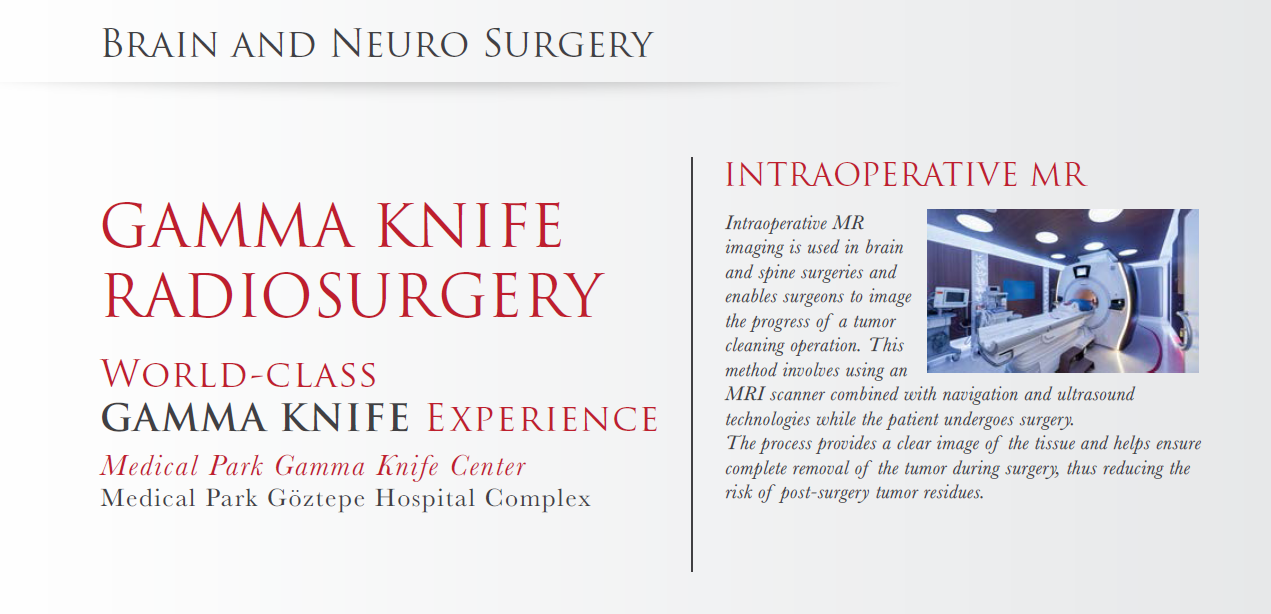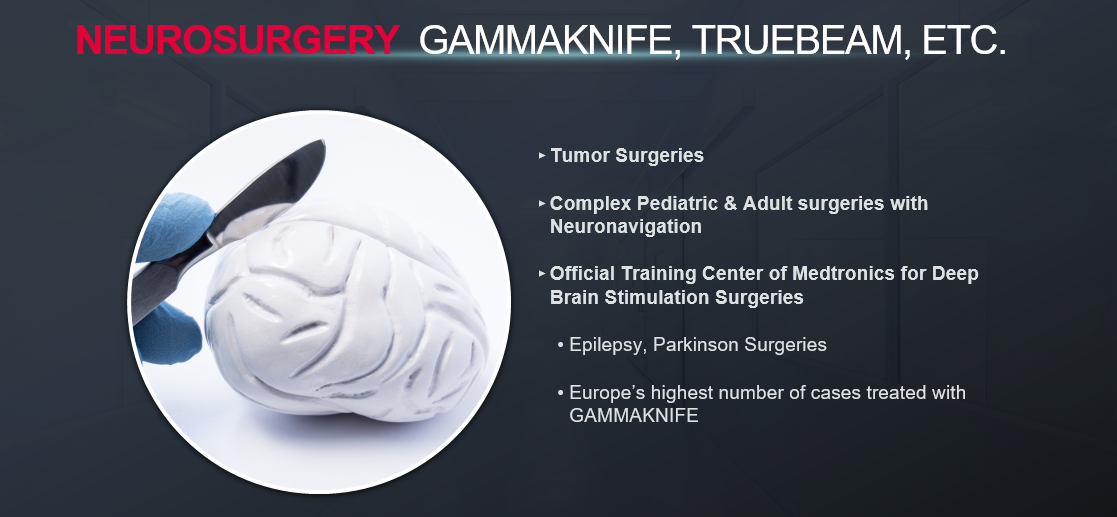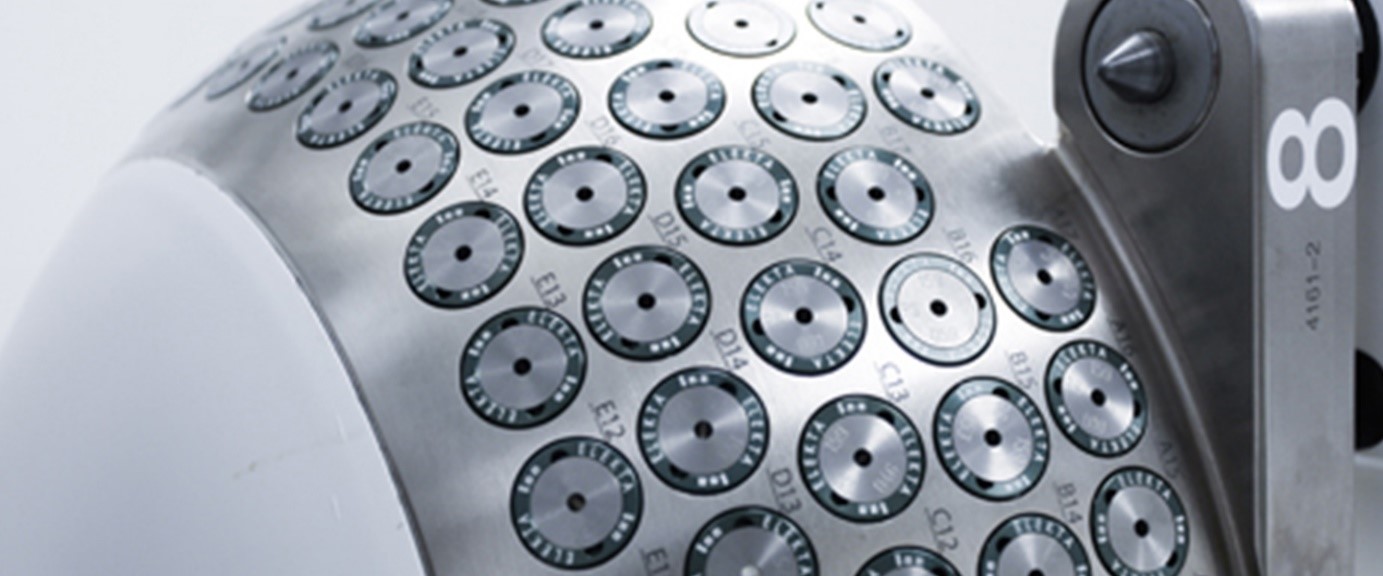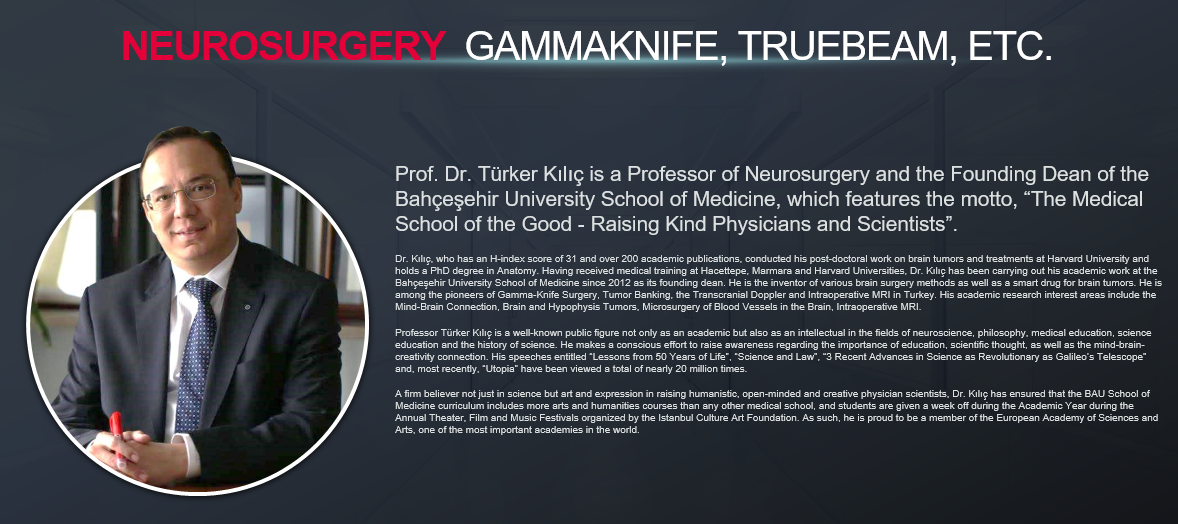Neurology
The Department of Neurology at Medical Park offers a full range of specialized neurological services, and specialists committed to providing state-of-the-art, all-inclusive care.
Medical Park Neurology & Neurosurgery Center programs are led by internationally recognized specialists who are the experts in diagnosing and treating the most complex brain and spinal disorders.
Stroke
Headache
Epilepsy
Movement disorders
Memory disorders
Hydrocephalus
Alzheimer's disease
Sleep disorders
Neuromuscular problems
are some of the diseases our patients can easily ask for physician consultations.
Furthermore, remote second opinion on neurological conditions and neurosurgery services are available for our patients, after you send us your medical reports, our experts will evaluate your reports and diagnostic test and you will be given a written recommendation regarding your treatment plans.
Medical Park is rated the World's 10th Most Excellent Center in Parkinson's Disease Surgery
The method applied in surgical treatment of Parkinson's Disease and many movement disorders success rate is 80%
Success is not a coincidence!
-
Advanced neuroradiologic imaging systems
-
Latest World-class scientific treatment methods
-
Highly skilled academis physicians
At Medical Park Hospitals' Neurosurgery Clinic , in Adult & Pediatric Cases;
-Brain Tumor Surgery
-Tremor Surgery
-Spinal Surgery
and other special treatment methods are applied…




Spine Surgeries
Aging, improper body mechanics, trauma and structural abnormalities can injure your spine, leading to back pain and other symptoms such as leg pain and/or numbness or even leg weakness.
The primary purpose of back surgery or neck surgery is to correct an anatomical lesion in individuals who fail to show improvement with conservative (nonsurgical) treatment. Surgery is not an option for patients when an anatomical lesion accounting for their pain can not be identified.
Surgery is only useful to change a patient's anatomy (e.g. remove a disc herniation). There is almost never any reason to consider exploratory surgery to “look" for a cause of pain.
The most important factor in the determination of the success in spine surgery is proper preoperative diagnosis. Without an accurate preoperative diagnosis, even the most technically successful surgery has little chance for a successful outcome.

Spine surgery can basically accomplish three tasks:
1. Decompress a nerve root or the spinal cord
2. Stabilize an unstable or painful segment with spinal fusion surgery
3. Reduce a deformity (e.g. scoliosis surgery in the thoracic spine)
Common surgical procedures
There are a number of conditions that may lead to spine surgery. Common procedures include:
-
Discectomy or Microdiscectomy: Removal of a herniated intervertebral disc. Therefore, removing pressure from the compressed nerve. Microdiscectomy is a MISS procedure.
-
Laminectomy: In this procedure, a surgeon removes parts of the bone, bone spurs, or ligaments in your back. This relieves pressure on spinal nerves and can ease pain or weakness. It can make your spine less stable. If that happens, you'll probably need a spinal fusion. Doctors sometimes do the two procedures together.
-
Laminotomy: Removal of a portion of the vertebral arch (lamina) that covers the spinal cord. A laminotomy removes less bone than a laminectomy.
Both laminectomy and laminotomy are decompression procedures. “Decompression" usually means tissuecompressing a spinal nerve is removed.
-
Foraminotomy: Removal of bone or tissue at/in the passageway (called the neuroforamen) where nerve roots branch off the spinal cord and exit the spinal column.
-
Disc replacement: As an alternative to fusion, the injured disc is replaced with an artificial one.
-
Spinal fusion: This is the most common surgery for back pain. The doctor will join spinal bones, called vertebrae, together. This limits the motion between them and how far your nerves can stretch. But it probably won't limit your activity. It's rare, but the bones don't always fuse completely. A surgical technique used to join two vertebrae. Spinal fusion may include the use of bone graft with or without instrumentation (eg, rods, screws). There are different types of bone graft, such as your own bone (autograft) and donor bone (allograft). A fusion can be accomplished by different approaches.
Parkinson's Disease
Brain pacemakers are complex electronic devices that have become increasingly popular in recent years in the surgical treatment of Parkinson's disease as well as a number of other movement disorders.
Gamma Knife Radio Surgery
Gamma Knife is a bloodless surgery for intra-cranial tumors and cerebral diseases without need to conventional surgery. Neurosurgeons use this method alone or along with microsurgery for eligible patients and diseases. Our team started performing Gamma Knife surgery on February 25, 1997. Prof. Türker Kılıç, M.D., is the first Turkish medical doctor to have radiosurgery training at Karolinska Institute, Sweden. Gamma Knife enjoyed gains from technological advanced and the methodology is still preferred by neurosurgeons worldwide. There are approximately half million people, who are treated with Gamma Knife Surgery worldwide. Approximately 1.6% of all those patients had been treated by your team. From this perspective, our team is among first five Gamma Knife units with highest case number.
Bloodless Surgery
Gamma Knife is an extremely sensitive and efficient device, also referred as radiosurgery, which uses radiation beams to treat intracranial tumors. Neurosurgeons, using this modality, focus radiation beams directly and accurately to the target area, with no negative influence on intact surrounding tissue. Radiosurgery enables neurosurgeons focus radiation beams directly and accurately to the target area, with no negative influence on intact surrounding tissue.
Studies demonstrated that Gamma Knife surgery has high success rate. For instance, a tumor at any localization in the brain can be controlled by >85 % (or in other words, tumor is successfully debulked). This modality is referred as Gamma Knife, since the radiosurgery (single-session treatment) has accurate efficiency on the target area and resultant changes are “surgical" in nature. However, no blade or scalpel is used, on the contrary to the name of the method. Therefore, this surgery is scalpel-free and bloodless and the complication risk is very low.
Use of three-dimensional computer-assisted planning and absolute immobility of the patient minimize delivery of radiation beams to intact brain tissue.
Approximately 200 cobalt-60 sources are loaded in each treatment unit. Those sources may generate thousands of beams, as thin as approximately a hair, at a very high sensitivity level (greater than 0.5 mm). Such beams are weak enough to have no hazardous influence of normal tissue through the tract to the target. However, when they are accurately focused on the target, beams merge in order to be sufficient for treating the target area.
On the contrary to multiple visits for linear accelerator (LINAC) therapies (fractional therapy) which use lower fractional doses, whole therapeutic dose can be given in single session, since Gamma Knife radiosurgery is extremely sensitive. Minimization of radiation dose is important for everybody, but especially for patients with cancer who are already maintained on other radiotherapy options. If low-sensitivity therapies are used for such patients, treatment may take up to 6 weeks for metastatic brain tumor, which implies a cancer spreading from the primary focus to other body parts.

